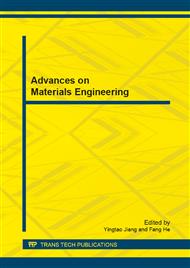p.217
p.222
p.227
p.235
p.240
p.246
p.250
p.255
p.261
Structure and Properties of Bisphenol a Polycarbonate Exposed to Ultraviolet
Abstract:
In this study, the structure and properties of bisphenol A polycarbonate (BPA-PC) after UVB-313 radiation were investigated. When BPA-PC was exposed to ultraviolet (UV), this polymer showed two different degradation mechanisms: photo-Fries rearrangement and photo-oxidation. The interpretation of the observed chemical degradation was based on attenuated total reflection IR (ATR). Gel permeation chromatograph (GPC) measurements indicated that the molecular weights of exposed surface sample were decreased with increasing of irradiation time, but the molecular weights of bulk polymer did not decrease severely. Namely, the degradation of BPA-PC was a surface phenomenon, which only extended about several micrometers into the exposed surface. This also could explain why the mechanical properties of samples showed no change. In addition, photo-induced yellowing of the aged PC was aggravated with the irradiation time prolonging, but no remarkable changes of light transmission have been observed.
Info:
Periodical:
Pages:
255-260
Citation:
Online since:
August 2013
Price:
Сopyright:
© 2013 Trans Tech Publications Ltd. All Rights Reserved
Share:
Citation:


